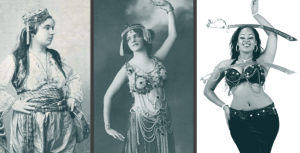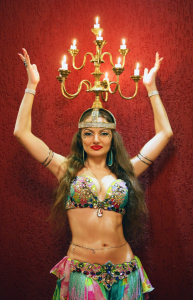Belying The Belly Dancer: Misconceptions of Raqs Sharqi That Need to Be Corrected In Your Writing
By J.D. Harlock
Introduction
The “belly dancer” is one of the most prevalent tropes western media has of Middle Easterners, and it’s often used as a cheap source of fan service in Middle Eastern and Arabesque settings. However, not only is this an insensitive portrayal of a revered traditional dance, but the inaccurate dress has become the de facto costume of Middle Eastern women in historical fiction, completely misrepresenting what Middle Eastern dress is actually like. If you’d like to portray these dancers accurately—either in historical/pseudo-historical settings or in the modern world and its analogs—the following points will clear up the misconceptions that writers outside of the Middle East tend to hold.
#1 – The name and nature of the dance
The term “belly dance” roughly translates to raqs al-baten, but nowhere in the Arab world is the dance ever referred to as that. What Arabs actually call it is Raqs Sharqi, i.e., “Eastern Dance” (in reference to the Middle East and North Africa), as contrary to popular belief, the dance does not solely focus on the motion of the midsection. In fact, the style allows for creative movement, with the motion of the entire body factoring into the dance.
Raqs Sharqi is not one specific choreography but has developed into forms that differ from country to country and even region to region — in style and costume. Ghawazee, Sa’idi, Awalim, and Raqs Baladi are but a few of the many forms that fall under Raqs Sharqi, and though techniques are shared, there is no universal naming scheme for their movements. Dancers and dance schools develop their own naming conventions, but none have become universally recognized.
#2 – The origins and purpose of belly dance
Raqs Sharqi was formally developed during the first half of the 20th century in Egypt, but its origins date back to 6,000 years ago. It began as a pagan practice celebrating female fertility and worshiping a feminine deity. The misconception that Raqs Sharqi originated in harems and was practiced for the express purpose of enticing men is a fantasy concocted in the late 1800s by western travelers and perpetuated by the Hollywood film industry. Europeans and Americans simply did not understand the movement vocabulary of this dance form, and during this time, movements of the torso were considered immoral in the west. The true history of the dance is, in fact, the opposite. Women and men were segregated in certain periods of traditional Middle Eastern societies, so this style of dance was often performed by women for other women in gatherings.
In the MENA (Middle East and North Africa), Raqs Sharqi is not necessarily an event performed on stage but is practiced for social gatherings at home and can be found at weddings and birthday celebrations. When it is a public event, it is usually a live performance at a festival or a stage in front of a crowd. Now, it is even promoted as a form of exercise that offers an aerobic workout that improves flexibility and strengthens the core.
#3 – The dress, the props, the accessories
The “bedlah,” or two-piece cabaret costume, is a Hollywood invention that dancers in the MENA adopted afterward, and it’s given westerners the wrong impression of what Raqs Sharqi dress looks like. The notion that Raqs Sharqi costumes have to be revealing is a common misconception. How much a dancer chooses to reveal all comes down to preference. Prior to the introduction of the bedlah, dancers dressed in different costumes depending on their location and social affiliation.

Marlene Dietrich dressed in A Bedlah in Kismet (1944)

Evolution of the Raqs Sharqi Costume
Traditional accessories included veils, headbands, and arm cuffs, but the one popularly associated with the dance today is the belly ring. This ring is not a traditional accessory but a recent Hollywood fashion trend introduced to sensualize the dance.
Chances are that a depiction of Raqs Sharqi will include a prop such as a sword or a veil. There is no evidence of traditional Raqs Sharqi dancers dancing with swords in the Middle East, nor that veil work (using the veil as a prop) was ever featured in a performance. These practices were created by Americans. The only use of a veil in traditional Raqs Sharqi is in the Egyptian version, where it is used to make an entrance and then promptly discarded. A traditional prop that was used, however, is the candelabrum. It was balanced on a dancer’s head in an act known as the shamadan. This is thought to have originated in Egypt, where it was performed at wedding ceremonies by professional dancers.

#4 – Who can perform Raqs Sharqi
Due to Hollywood creating and perpetuating certain stereotypes of Raqs Sharqi, it often comes as a surprise that not only do male practitioners exist, but that this is not a recent phenomenon. Even though popular depictions of Raq Sharqi only offer up an image of a certain body type practicing it, one of the appeals of Raqs Sharqi is that it can be performed by people of all shapes and sizes. The community actively promotes an inclusive image of who is able to perform the dance and all are welcome to try it out.
Today, Raqs Sharqi is a worldwide phenomenon practiced by people of all shapes, sizes, and backgrounds. Even if these dancers never feature in your writing, chances are you’ll come across writing that does feature it. Now, however, you are equipped with the knowledge needed to correct the misconceptions that have unfairly maligned a community of artists that, in spite of them, have kept a revered Middle Eastern tradition alive and well to this very day.
 J.D. Harlock is a Syrian Lebanese Palestinian writer and editor based in Beirut. In addition to his posts at Wasafiri, as an editor-at-large, and at Solarpunk Magazine, as a poetry editor, his writing has been featured in New Lines Magazine, Strange Horizons, Star*Line, Nightmare Magazine, and the SFWA Blog. You can always find him on Twitter and Instagram, posting updates on his latest projects.
J.D. Harlock is a Syrian Lebanese Palestinian writer and editor based in Beirut. In addition to his posts at Wasafiri, as an editor-at-large, and at Solarpunk Magazine, as a poetry editor, his writing has been featured in New Lines Magazine, Strange Horizons, Star*Line, Nightmare Magazine, and the SFWA Blog. You can always find him on Twitter and Instagram, posting updates on his latest projects.


